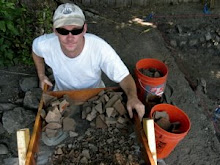MTU has decided upon the site for our 2010 Field School in Industrial Archaeology: The Cliff Mine (1845-1870).
Iron chimney projects above a stone stack on the site of the Cliff Mine.
Join the Industrial Archaeologists from Michigan Technological University during May and June of 2010, helping document an historic mid-nineteenth century native copper mine in the heart of the Keweenaw Peninsula. The Keweenaw is famous as one of the few places on earth where humans found abundant lumps of raw copper, ranging in size from pebbles to record-breaking boulders of pure metal. We anticipate studying the ruins of the Cliff Mine (1845-1870), one of the region's earliest and most profitable mass copper mines. The site sits atop and below the 200-foot greenstone bluff that runs along the spine of the Keweenaw Peninsula, about 30 miles northeast of Houghton, Michigan. We will be reconstructing the evolution of the industrial process using clues left by the workers as they built, worked, and reworked the site's shafts, mill, engine house, kilns, stacks, shops, houses, and offices.
MTU IA grad student Craig Wilson at the base of a stack at the Cliff Mine.
The field school participants will learn multiple documentation techniques, such as digital and optical mapping; use of GPS and remote sensing in survey; learn measured drawing and drafting; taking architectural, archaeological, and object photographs; and undertake some excavations and artifact analysis specifically designed for industrial heritage and archaeology. Along with fieldwork, there will be field trips, lectures, and discussions devoted to the history and technology of early copper mining in the Keweenaw, archaeological method and theory, and issues of ethics and heritage preservation for industrial heritage sites.
Looking over a waste rock pile at the 200 foot bluff that splits the site into upper and lower sections.
More information here:
http://www.ss.mtu.edu/faculty/Scarlett/Summer/FieldSchools.htm





